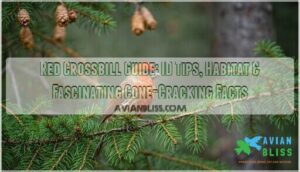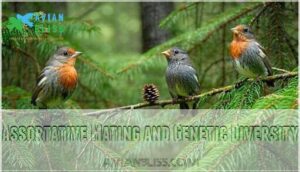This site is supported by our readers. We may earn a commission, at no cost to you, if you purchase through links.

Males display vibrant red to yellow-orange plumage, while females show more subdued gray-green tones.
These medium-sized finches roam North America’s coniferous forests from Alaska to Mexico, following cone crop cycles in nomadic flocks.
Their bills vary in size and shape, perfectly adapted to different conifer species.
What makes these birds truly remarkable isn’t just their tool-like beaks, but their flexible breeding cycles that can occur anytime cone crops peak—even mid-winter, making them a fascinating example of nomadic flocks.
Table Of Contents
- Key Takeaways
- Red Crossbill Overview
- Red Crossbill Habitat
- Red Crossbill Behavior
- Red Crossbill Types and Speciation
- Red Crossbill Adaptation and Ecology
- Frequently Asked Questions (FAQs)
- Where are Red Crossbills found?
- What is the difference between a crossbill and a house finch?
- How do you identify a Red Crossbill?
- Are Red Crossbills endangered?
- How do you identify a red crossbill?
- What is the difference between a red crossbill and a pine grosbeak?
- What is the difference between purple finch and Red Crossbill?
- What is the legend of the Red Crossbill?
- What is the use of a crossbill?
- What kind of bird is a crossbill?
- Conclusion
Key Takeaways
- You’ll recognize red crossbills by their unique crossed bill tips that work like specialized pliers, perfectly designed for prying open tough conifer cones that other birds can’t access.
- You can expect to find these nomadic wanderers following cone crops across North America’s coniferous forests, with flexible breeding cycles that occur whenever food is abundant—even in mid-winter.
- You’ll notice remarkable diversity within the species, with at least eleven distinct "call types" that may actually be separate species evolving different bill shapes and vocalizations for specific conifer specialization.
- You’ll observe fascinating survival strategies including acrobatic feeding behaviors, year-round seed extraction abilities, and complex social flocking patterns that help them thrive in unpredictable forest environments.
Red Crossbill Overview
You’ll recognize a Red Crossbill by its unique twisted bill that crosses at the tips, creating an X-shaped tool perfectly designed for prying open conifer cones.
This medium-sized finch displays remarkable color variation, with males ranging from deep red to bright yellow-orange and females showing gray-green to yellow tones, which can be considered a key color variation.
Physical Characteristics
You’ll notice red crossbills display remarkable bill morphology with their signature twisted bill crossing at the tips.
These stocky finches show significant plumage variation between sexes—males range from deep red to yellow-orange while females appear gray-green to yellow.
Size dimorphism isn’t pronounced, but bill shapes vary considerably among populations.
Juvenile markings include brown-streaked plumage with whitish underparts, and their notched tail structure distinguishes them from other finches.
Red crossbills differ from the white-winged crossbill, which has distinct plumage.
Identification Features
You’ll spot red crossbills by their unique crossed bill morphology—mandibles that literally cross at the tips like tiny scissors.
Males display striking plumage variation from deep red to yellow-orange, while females show gray-green to yellowish tones.
Juvenile markings include heavy brown streaking on whitish underparts.
For size comparison, they’re medium finches, slightly larger than Purple Finches but smaller than cowbirds, making field identification easier through distinctive flight calls.
Accurate identification relies on detailed species guides.
Taxonomy and Subspecies
You’ll find Loxia curvirostra represents one of ornithology’s most complex taxonomic puzzles.
Over 20 crossbill subspecies exist worldwide, with North American populations divided into distinct call types that correspond to genetic variability and speciation mechanisms.
These crossbill types demonstrate remarkable subspecies identification challenges, as hybridization potential complicates traditional bird subspecies classification systems.
Red Crossbill Habitat
You’ll find Red Crossbills throughout North America’s coniferous forests, from Alaska’s boreal regions to Mexico’s mountainous pine forests.
These specialized birds adapt their range and movements to match the abundance of cone crops, making them highly nomadic as they follow food sources across vast geographic areas.
Geographic Distribution
You’ll find Loxia curvirostra across vast regions of North America’s coniferous forests, from Alaska to Mexico’s mountains.
This Global Range spans boreal forests, montane regions, and scattered populations in eastern woodlands.
Bird distribution patterns show Regional Abundance fluctuating with cone crop cycles, creating dynamic Migration Patterns that make tracking bird populations challenging across their extensive Habitat Variation zones.
Regional Differences
Red Crossbill call type variation creates distinct regional populations across North America.
The Pacific Northwest hosts the greatest diversity with multiple crossbill types, while eastern regions support fewer varieties.
Morphological differences in bill size match local conifer species, driving habitat specialization and dietary adaptations.
These crossbill subspecies show genetic divergence through assortative mating patterns, with each call type preferring specific breeding partners within their specialized ecological niches.
Their unique bills allow them to access conifer seeds efficiently through efficient means.
Adaptation to Coniferous Trees
You’ll find Red Crossbills perfectly engineered for coniferous forests through remarkable cone specialization.
Their unique bill morphology creates crossed mandibles that function like specialized tools for seed extraction from tightly closed cones.
Nature’s perfect can opener – crossed bills that pry open the toughest cones with surgical precision
Different call types show distinct beak morphology adaptations – larger bills tackle hefty pine cones while smaller bills handle delicate spruce seeds.
This habitat dependence means each population’s dietary adaptations match their local conifers perfectly, making conifer seeds accessible year-round through precise cone adaptation mechanisms, which is a result of their unique bill morphology and specialized tools.
Red Crossbill Behavior
You’ll notice Red Crossbills exhibit fascinating behaviors perfectly suited to their coniferous lifestyle.
Their nomadic flocking patterns and specialized feeding techniques reveal remarkable adaptations for extracting seeds year-round from closed cones, showcasing their ability to thrive in such environments with specialized techniques.
Foraging and Feeding Habits
Watching crossbills work their magic reveals nature’s precision engineering in action.
Their specialized beaks function like botanical can openers, systematically prying apart cone scales that other birds can’t access.
This cone specialization drives their entire lifestyle, creating nomadic flocks that follow abundant seed crops across vast territories.
- Seed extraction techniques vary by call type, with bill morphology perfectly matched to target conifer species
- Grit consumption from roadsides aids digestion of tough conifer seeds during winter months
- Diet variation includes pine buds, berries, and insects when cone crops fail
- Crossbill diet flexibility allows survival in unpredictable coniferous environments where feeding behavior must adapt quickly
To supplement their natural diet, consider offering a specialized seed mix.
Social Structure and Flocking
Throughout their lives, Red Crossbills exhibit fascinating flock dynamics that showcase complex social hierarchy patterns.
You’ll observe these flocks maintaining tight-knit groups year-round, with pair bonding occurring within the social structure.
Their nomadic behavior drives constant movement as they search for abundant cone crops.
Group foraging becomes highly efficient through coordinated efforts, with bird vocalizations facilitating communication during irruptions across vast territories.
Breeding and Nesting Patterns
Unlike most birds, crossbills’ breeding cycles follow nature’s irregular timetable rather than seasons.
You’ll witness their extraordinary flexibility as they nest whenever cone crops peak—sometimes mid-winter, sometimes spring.
Females construct sturdy nests using twigs and moss, laying 3-4 eggs requiring two weeks’ incubation.
Both parents share demanding parental care duties, feeding nestlings regurgitated seeds until fledging success occurs after 15-20 days.
Their nest construction emphasizes safety from predators to ensure protection.
Red Crossbill Types and Speciation
You’ll discover that Red Crossbills represent one of North America’s most fascinating examples of ongoing speciation, with at least eleven distinct "call types" that may actually be separate species in disguise.
Scientists now recognize that these different forms exhibit specialized bill shapes, unique flight calls, and strong preferences for specific conifer species—traits that suggest they’re evolving into distinct species right before our eyes, through a process of ongoing evolution.
Cassia Crossbill Speciation
Scientists have discovered something remarkable in southern Idaho’s mountains.
The Cassia Crossbill represents a textbook example of speciation mechanisms in action.
This population evolved genetic isolation from other crossbill call types through adaptive divergence in bill size and conifer specialization.
Their deeper bills perfectly match local lodgepole pine cones, creating strong conservation implications for this range-restricted species requiring targeted future research.
The Cassia Crossbill is endemic to Idaho, specifically the South Hills and Albion Mountains.
Assortative Mating and Genetic Diversity
Red crossbill populations demonstrate fascinating assortative mating patterns where individuals preferentially mate within their call type.
This behavior maintains genetic diversity across different forms while creating potential genetic bottlenecks within specific types.
Each call type’s specialized mating preferences reduce hybridization risks between forms adapted to different conifers.
- Mating Preferences: Birds choose partners with matching call types and bill morphology
- Genetic Bottlenecks: Small breeding populations within types limit gene flow
- Hybridization Risks: Cross-type breeding could dilute specialized adaptations
- Inbreeding Depression: Limited genetic diversity may reduce fitness over time
- Conservation Genetics: Understanding bird genetics helps protect distinct evolutionary lineages
Ongoing Research and Taxonomy Implications
Ongoing research is revolutionizing our understanding of Red Crossbill diversity through genomic studies and citizen science contributions.
Scientists are using advanced acoustic monitoring and DNA analysis to clarify species delineation among call types. The recent identification of Type 12, or Northeastern Crossbill, demonstrates how call variability reveals hidden diversity.
Bird genetics research continues uncovering new populations. Notably, the related white winged crossbill sometimes breeds opportunistically.
| Research Area | Key Findings |
|---|---|
| Call Type Evolution | Digital monitoring reveals 11+ distinct types with specialized vocalizations |
| Conservation Genetics | Genomic analysis shows subtle but significant genetic distinctions among types |
| Citizen Science Impact | eBird submissions help map call variability and fill knowledge gaps |
Red Crossbill Adaptation and Ecology
You’ll discover how Red Crossbills have evolved remarkable adaptations that make them one of nature’s most specialized seed extractors.
These birds demonstrate extraordinary ecological flexibility, with different populations developing unique bill shapes and feeding strategies that allow them to thrive in diverse coniferous forests across North America, showcasing their ecological flexibility.
Cone Specialization and Ecological Significance
Red crossbill conifer specialization creates remarkable ecosystem relationships.
Each call type’s beak morphology matches specific cone structures, enabling efficient seed extraction. This niche partitioning reduces competition while supporting forest health through:
- Targeted seed dispersal across conifer habitats
- Cone opening that releases seeds naturally
- Population control of competing seed-eaters
- Cross-pollination facilitation between forest patches
- Genetic diversity maintenance in conifer stands
Their conifer dependence shapes entire forest dynamics.
For help with crossbill species recognition, consult field guides.
Diet Flexibility and Survival Strategies
Beyond specializing on specific cone crops, you’ll find these birds master remarkable survival tactics through their flexible diet and nomadic behavior.
These finches turn survival into an art form, following cone crops like nomads chasing nature’s abundance.
Their winter breeding cycles sync perfectly with peak seed availability, while their acrobatic feeding skills let them extract resources year-round.
- Nomadic Behavior: Flocks travel hundreds of miles tracking abundant cone crops across different forest regions
- Grit Consumption: Birds regularly consume sand and small stones from roadsides to help digest tough conifer seeds
- Seed Specialization: Different bill sizes allow access to various pine species, from small lodgepole to massive sugar pine cones
- Winter Breeding: Unlike most songbirds, crossbills nest during harsh winter months when cone crops peak
- Acrobatic Feeding: They hang upside-down and twist at impossible angles to reach seeds inside tightly closed cones
Conservation Status and Threats
Currently, Red Crossbills as a group are widespread and common, but some forms are localized, specialized, and vulnerable to habitat loss.
Although their global population is considered stable, Red Crossbills are showing declines in North America, likely due to habitat loss .
Climate change affects cone production while forest management practices reduce suitable breeding sites. Vehicle collisions kill many birds feeding on roadside grit.
Certain threatened species like the Cassia crossbill face severe population decline from wildfires, emphasizing urgent conservation efforts. These declines mirror the broader trend where habitat loss endangers birds, highlighting the need for climate change mitigation and wildlife protection.
Frequently Asked Questions (FAQs)
Where are Red Crossbills found?
You’ll find these nomadic wanderers absolutely everywhere conifers grow! They’re constantly roaming North America’s forests, from Canada’s boreal regions through western mountains and northeastern woodlands, following cone crops.
What is the difference between a crossbill and a house finch?
You’ll spot the difference immediately: crossbills have uniquely twisted bills that cross at the tips for extracting conifer seeds.
While house finches have straight, cone-shaped bills for eating various seeds and fruits.
How do you identify a Red Crossbill?
Look for a stocky, medium-sized finch with a distinctive crossed bill that forms an X at the tips.
Males display red to yellow-orange plumage, while females appear gray-green to yellow with dark brown wings.
Are Red Crossbills endangered?
Currently, populations remain stable across North America, though you’ll find these specialized finches aren’t considered endangered despite their irregular, nomadic movements following cone crops that create temporary local scarcities.
How do you identify a red crossbill?
You’ll recognize this distinctive finch by its unique crossed bill tips that form an X shape.
Males display red to yellow-orange coloring, while females appear gray-green to yellowish, both lacking white wingbars.
What is the difference between a red crossbill and a pine grosbeak?
You’ll notice a red crossbill has a distinctly crossed, X-shaped bill tip, while a pine grosbeak sports a thick, stubby, straight beak for cracking seeds efficiently.
What is the difference between purple finch and Red Crossbill?
You’ll spot massive differences between these finches instantly! Purple Finches lack the Red Crossbill’s trademark crossed mandibles and show streaky brown patterns instead of solid red coloring in males.
What is the legend of the Red Crossbill?
According to Christian folklore, a plain little brown bird tried to help Christ during crucifixion by attempting to remove the nails from his limbs.
This act of compassion blessed the bird with its distinctive crossed beak and red feathers.
The Red Crossbill’s unique characteristics make it a popular candidate for the official Christmas bird symbol, symbolizing Christmas spirit.
What is the use of a crossbill?
You’ll find crossbills use their uniquely twisted beaks like specialized tools, prying apart tough conifer cone scales to extract seeds that other birds can’t reach effectively.
What kind of bird is a crossbill?
Crossbills comprise cleverly crafted finches with uniquely crossed mandibles that you’ll recognize by their distinctive X-shaped bills.
You’ll spot these medium-sized songbirds specializing in extracting conifer seeds from closed cones year-round.
Conclusion
Like a master craftsman with perfectly designed tools, the red crossbill demonstrates nature’s incredible precision in form-function relationships.
Their nomadic lifestyle, flexible breeding patterns, and diverse subspecies showcase evolutionary adaptation at its finest.
Whether you’re observing their acrobatic feeding behaviors or listening for their distinctive flight calls, red crossbills offer endless fascination for birders and nature enthusiasts seeking to understand ecological specialization in action, and how these remarkable birds use their specialized crossed bills to access conifer seeds that remain inaccessible to other species, exemplifying remarkable birds.












